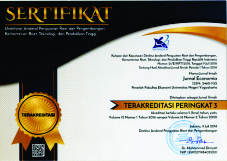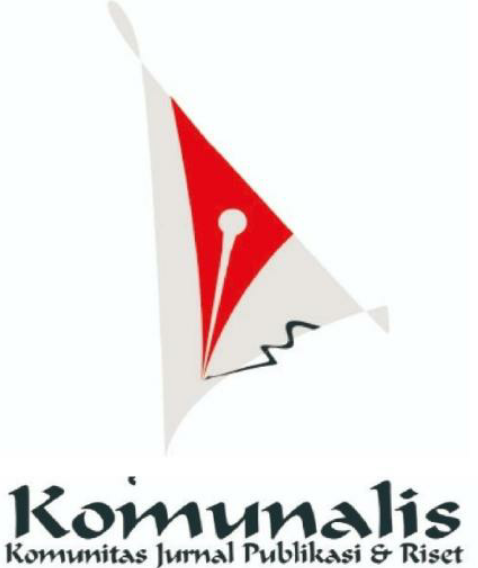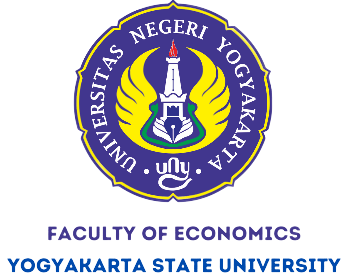The Effect of Ownership Structure on Dividend Policy in The Manufacturing Companies
Downloads
Abstract: The Effect of Ownership Structure on Dividend Policy in The Manufacturing Companies. Ownership structure; as independent variables in this research; is represented by institutional ownership and managerial ownership. This research also aimed to obtain evidence of moderation function of the concentration of ownership in the relationship between ownership structure and dividend policy. The dependent variable is dividend policy which is measured by Dividend Payout Ratio (DPR). There are 97 sample companies. Hypothesis testing is done by Moderating Regression Analysis (MRA) and panel regression analysis. The results of this research show that the concentration of ownership serves as a moderating variable on the relationship between ownership structure and dividend policy. Institutional ownership in companies that do not have a managerial ownership has a negative effect on Dividend Payout Ratio; while institutional ownership in companies that have a managerial ownership has a positive effect on Dividend Payout Ratio. Profitability and company size as a control variable has effect on dividend policy.
Keywords: the concentration of ownership, institutional ownership, managerial ownership, ROA, company size, dividend payout ratio
Abstrak: Pengaruh Struktur Kepemilikan Terhadap Kebijakan Dividen pada Perusahaan Manufaktur. Struktur kepemilikan sebagai variabel independen dalam penelitian ini diproksikan dengan kepemilikan institusional dan kepemilikan manajerial. Penelitian ini juga untuk mendapatkan bukti mengenai fungsi moderasi dari konsentrasi kepemilikan dalam hubungan antara struktur kepemilikan dan kebijakan dividen. Variabel dependen adalah kebijakan dividen yang diukur dengan Dividend Payout Ratio (DPR). Sampel yang diperoleh sebanyak 97 perusahaan selama tahun pengamatan. Pengujian hipotesis dilakukan dengan Moderating Regression Analysis dan analisis regresi data panel. Hasilnya menunjukkan bahwa konsentrasi kepemilikan berfungsi sebagai variabel moderating pada hubungan antara struktur kepemilikan dan kebijakan dividen. Untuk kepemilikan institusional pada perusahaan yang tidak mempunyai kepemilikan manajerial berpengaruh negatif terhadap Dividend Payout Ratio, sedangkan kepemilikan institusional pada perusahaan yang mempunyai kepemilikan manajerial berpengaruh positif. Kepemilikan manajerial berpengaruh positif terhadap Dividend Payout Ratio. Variabel kontrol profitabilitas dan ukuran perusahaan berpengaruh pula terhadap kebijakan dividen perusahaan.
Kata Kunci: konsentrasi kepemilikan, kepemilikan institusional, kepemilikan manajerial, ROA, ukuran perusahaan, dividend payout ratio
Downloads
Afza, T. dan H. H. Mirza. (2010). Ownership Structure and Cash Flows As Determinants of Corporate Dividend Policy in Pakistan. International Business Research. 3(3), 210–221.
Aharony, J. & I. Swary. (1980). Quarterly Dividend and Earnings Announcements and Stockholders Returns: An Empirical Analysis. The Journal of Finance. 35(1), 1-12.
Allen, F.; dan R. Michaely. (2001). Payout Policy. Working Paper. The Wharton School.
Amihud, Y.; dan K. Li. (2002). The Declining Information Content of Dividend Announcements and the Effects of Institutional Holdings. Journal of Financial and Quantitative Analysis, 41(3), 637-660.
Anderson, W. (2009). Alternative Event Study Methodology for Detecting Dividend Signals in The Context of Joint Dividend and Earnings Announcements. Accounting and Finance, 49(2), 247–265.
Azhagaiah, R.; dan S. Priya. (2008). The Impact of Dividend Policy on Shareholders' Wealth. International Research Journal of Finance and Economics, 181-187.
Bandi. (2009). Kualitas Laba Dalam Perspektif Akrual-Arus Kas Dan Persinyalan Dividen. Disertasi S3 Program Pasca Sarjana UNDIP; Semarang.
Brickley, J. A. (1983). Shareholder Wealth; Information Signaling and The Specially Designated Dividend. Journal of Financial Economics, 12, 187-209.
Bulan, L.; N. Subramanian; dan L. Tanlu. (2007). On The Timing Of Dividend Initiation. Financial Management, 36(4), 31-65.
Chasanah, A.N. (2008). Faktor-Faktor Yang Mempengaruhi Dividend Payout Ratio (DPR) Pada Perusahaan Yang Listed Di Bursa Efek Indonesia (Perbandingan Pada Perusahaan Yang Sebagian Sahamnya Dimiliki Oleh Manajemen Dan Yang Tidak Dimiliki Oleh Manajemen). Masters Thesis. Program Pasca Sarjana Universitas Diponegoro.
Chen, J.; dan N. Dhiensiri. (2009). Determinants of Dividend Policy: The Evidence from New Zealand. International Research Journal of Finance and Economics, 34, 18-28.
Cornett; M. M.; A. Fayman; A. J. Marcus; dan H. Tehranian. (2011). Dividends; Maturity; And Acquisitions : Evidence From a Sample of Bank IPOs. Review of Financial Economic, 20, 11-21.
D'Souza, J.; dan A. K. Saxena. (1999). Agency Cost; Market Risk; Investment Opportunities and Dividend Policy – An International Perspective. Managerial Finance, 25(6), 35.
Denis, D.J. dan I. Osobov. (2008). Why Do Firms Pay Dividends? International Evidence On Determinants Of Dividend Policy. Journal of Financial Economic, 89, 62-82.
Dickens, R.N.; K. M. Casey; dan J. A. Newman. (2002). Bank Dividend Policy: Explanatory Factors. Quarterly Journal of Business Economic, 41(1), 3-12.
Djumahir. (2009). Pengaruh Biaya Agensi; Tahap Daur Hidup Perusahaan; dan Regulasi terhadap Kebijakan Dividen pada Perusahaan Manufaktur di BEI. Jurnal Manajemen dan Kewirausahaan, 11(2), 144-153.
Fauz, A.; dan Rosidi. (2007). Pengaruh Aliran Kas Bebas; Kepemilikan Manajerial; Kepemilikan Institusional; Kebijakan Utang; dan Collateral Asset Terhadap Kebijakan Dividen. Jurnal Ekonomi dan Manajemen, 8(2).
Ferris, S. P.; N. Sen; dan H. P. Yui. (2006). God Save The Queen and Her Dividends: Corporate Payouts In The
Grinstein, Y.; dan R. Michaely. (2005). Institutional Holdings and Payout Policy. The Journal of Finance, 60(3), 1389-1426.
Hartono; R. A; dan A. D. R. Atahau. 2007. Analisis Interdependensi Insider Ownership. Jurnal Ekonomi dan Bisnis, 13(1), 1-19.
Haruman, T. (2008). Pengaruh Struktur Kepemilikan Terhadap Keputusan Keuangan dan Nilai Perusahaan. Simposium Nasional Akuntansi XI; Pontianak.
Huang, G.; dan Q. Li. (2006). Influence of Institutional Ownership on Cash Dividend Policy of China Listed Companies. The Sixth Wuhan International Conference on E-Business ï¼International Finance Track.
Jensen, M. C.; dan W. Meckling. (1976). Theory of the firm: Managerial behavior; agency costs and capital structure. Journal of Financial Economics, 3, 305–360.
Koch, A. S.; dan A. X. Sun. (2004). Dividend Changes and the Persistence of Past Earnings Changes. Journal of Finance, 59(5), 2093-2116.
Kumar; S. 2007; Analisis Pengaruh Struktur Kepemilikan; Investment Opportunity Set (IOS); dan Rasio-Rasio Keuangan Terhadap DPR. Tesis. Program Pasca Sarjana Magister Manajemen Universitas Diponegoro.
Liu; C. dan A. S. Chen. (2015). Do Firms Use Dividend Changes To Signal Future Profitability? A Simultaneous Equation Analysis. International Review of Financial Analysis, 37, 194–207
Lucyanda, J. dan Lilyana. (2012). Pengaruh Free Cash Flow dan Struktur Kepemilikan terhadap Dividend Payout Ratio. Jurnal Dinamika Akuntansi. Vol. 4; No. 2; hlm. 129–138.
Mehrani, S.; M. Moradi; dan H. Eskandar. (2011). Ownership Structure and Dividend Policy: Evidence from Iran. African Journal of Business Management, 5(17), 7516-7525.
Moh'd, M. A. ; L. G. Perry; dan J. N. Rimbey. (1998). The Impact of Ownership Structure on Corporate Debt Policy: A Time-Series Cross-Sectional Analysis. The Financial Review, 33, 85-99.
Papadakis, V. M.; S. Lioukas; dan D. Chambers. (1998). Strategic Decision-Making Processes: The Role of Management and Context. Strategic Management Journal; 19(2), 115-147.
Rahayu, S. A. T. (2012). Modul Laboratorium Ekonometrika (Dengan Aplikasi Eviews). Jurusan Ekonomi Pembangunan; Universitas Sebelas Maret.
Rosdini, Dini. (2009). Pengaruh Free Cash Flow terhadap Dividend Payout Ratio. Working Paper in Accounting and Finance. Departemen of Accounting; Padjadjaran University, 1–9.
Shleifer, A.; dan R. Vishny. (1986). Large Shareholders and Corporate Control. Journal of Political Economy; Vol. 94; hlm. 461- 488.
Short, H.; H. Zhang; dan K. Keasey. (2002). The Link between Dividend Policy and Institutional Ownership. Journal of Corporate Finance, 8, 105-122.
Sisca, C. D. (2008). Pengaruh Kepemilikan Manajerial; Kepemilikan Institusional; Kebijakan Utang; Profitabilitas; dan Ukuran Perusahaan terhadap Kebijakan Dividen. Jurnal Bisnis dan Akuntansi, 10(1),47-58.
Taman, Abdullah dan Billy; A. N. (2011). Determinan Kualitas Implementasi Corporate Governance pada Perubahan yang Terdaftar di Bursa Efek Indonesia (BEI) Periode 2004-2008. Jurnal Pendidikan Akuntansi Indonesia. 9(1).
Thanatawee, Yordying. (2013). Ownership Structure and Dividend Policy: Evidence from Thailand. International Journal of Economics and Finance, 5(1), 121–132.
Ullah, H.; A. Fida; dan S. Khan. (2012). The Impact of Ownership Structure on Dividend Policy Evidence from Emerging Markets KSE-100 Index Pakistan. International Journal of Business and Social Science. 3(9), 298–307.















